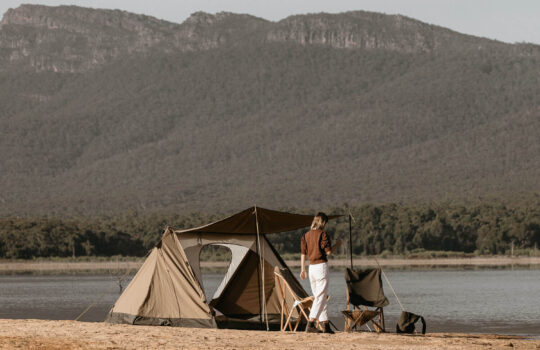Walking your first long distance trail? The only thing that can match the thrill of your upcoming adventure is the feeling of overwhelm which comes with attempting to plan and prepare for your trip.
From how to get to the start of the route, and what to take, to what to expect on the way, and even what essentials to pack.
That’s why we have taken the time to round up a full rucksack load of tips and tricks for walking your first long distance trail in the UK. Partially put together with the help of our experienced community of long distance hikers.
This article is designed for walkers staying in hostels and B&B’s rather than camping or wild camping.
Plan Early
Long distance hiking is only growing in popularity. UK trails are some of the best in the world and despite our relatively small size as a nation, we have a lot of walking on offer. That being said, there are some trails which tend to attract a lot of attention, and its perfectly OK if you have planned to walk one of the busiest routes. For example the West Highland way, Hadrian’s wall Path, or South West Coast Path.
Rooms sell out quickly on these routes, so to avoid lengthy transfers to and from the trail, in a hotel several miles from the route, plan early. 6-12 months in advance is ideal for getting availability in the hotels you want, but if you can plan easier than that, you have the first pick.
Book Direct for the best price
To get the best room rate in a B&B, Hotel or Hostel, book direct, especially if the place you want to book with is showing availability on Booking.com, Expedia etc. Often these sites take a big commission, and your accommodation will be delighted to offer a small discount for your direct booking.
Book online for speed
That being said, if you don’t have time to call around and book direct then most places can now be booked online. Be sure to double check that the accommodation you are booking is in the right location, and make sure you are aware of some of the different cancelation and payment policies before you commit. Most B&B’s are pay on arrival or departure, but many will also want to take card details as a backup, or a small deposit.
Be careful of AirBnB
I’ve not got much against AirBnB. I’ve used it myself lots of times. However luggage transfer companies do sometimes struggle to deliver to unmanned accommodations. Make sure that if your AirBnB is a remote access accommodation, or is a homestay, that somebody is there to receive, and hand over your luggage if thats being moved for you.
Make table reservations
If booking your own trip, be sure to make table reservations at local restaurants. Some destinations and overnight stops get very busy, and with only one or two restaurants available the spaces fill up quickly. To avoid disappointment, call in advance and book yourself a table. You will thank yourself for it later.
Compare luggage transfer costs
On most of the major long-distance trails, you will find a range of luggage transfer options. Compare costs and weight limits as they all vary a little. On all of our walk pages, we offer a luggage transfer comparison to help you get the best rates and prices.
Don’t skip the travel insurance
If coming from overseas don’t skimp on travel insurance. Our health service is free for some services to international visitors, but not all.
Shop around if you use a tour operator
You may have come across a number of tour operators on you way to this article. Thats great, and I imagine you may be considering booking with one of them. Be sure to do your homework on tour operators. Some are better than others.
Buy train tickets early, but no too early.
The optimal time to buy your train tickets is 12 weeks ahead of travel. You can buy all train tickets online, which is cheaper, and easier than buying them at the stations. Also, many rural stations, which are often the gateway to the start of your walk do not have ticket machines so buying tickets here is not possible.
Don’t expect nice trains like in the EU
Our trains are old and outdated, especially on lesser-used lines. Don’t expect them to be modern trains like in the EU unless you’re on a long journey on a mainline.
Check parking arrangements in advance
If you are planning on arriving at the start of your walk by car, be sure to pre-book a car parking space in advance. If you are staying at a B&B or Inn sometimes this is available. Alternatively, there are car parking apps that allow you to rent a private space on a driveway.
Carry cash
The vast majority of businesses will take card payments. If you are traveling from overseas make sure you have a debit card, such as a Visa Debit. Also, have a float of cash for grabbing an ice cream or hailing a cab in an emergency.
Call your B&B’s ahead of time
If you are staying with B&B’s it’s really helpful to give them a call ahead of time to let them know when you will be arriving. The difference between a hotel and B&B is the host will be expecting you and will be concerned if you don’t show. You will also have an opportunity to discuss your breakfast options with your host.
Expect to be offered a full English each day
A full English breakfast is a typical offering at most accommodation. You may well get very fed up with them after 14 days of walking. Don’t worry, cereal and toast are also on offer.
Don’t pack your laptop
The best advice here is to keep it simple. And unless you are planning on incorporating your hike into a work trip, leave the laptop or tablet at home! Enjoy the opportunity to disconnect from the world and save yourself the risk of expensive electronics being damaged in transit.
Pack light
Talking about your day pack here assuming your having your bags moved. Pack light during the day. You don’t need as much as you think you do.
Look after your feet
I recommend bringing a lightweight first aid kit. As part of that kit have some foot care kit. Fix up hot spots before they turn into blisters, and give your feet room to breath on longer days (taking shoes off during lunch). Also keep stones out of your boots.
Go slow
There will be lots to see on your trail. From the many varieties of trees, streams and rivers, distant views, wildlife, beautiful stone-built cottages. Your walk will be rich in history and culture and the people you meet will be friendly and welcoming. Take it slow, enjoy it as if you’re sipping on a well-aged wine or enjoying some decadent chocolate.
Expect bad weather
Optimism is important, and here at DistanceHiker we have an optimistic outlook on life. However when it comes to the british weather, verge on the side of caution with the weather. Even if your not walking on higher ground, be sure to pack essentials for bad weather such as waterproof trousers and jackets. We can get bad weather in the middle of th summer months, despite increasingly warmer temperatures year on year.
Pack sunscreen
As the previous point it is getting warmer each year. Pack sunscreen. Theres a good chance you will need it if you are walking in the summer months.
Plan miles you can manage
A lot of guidebooks will be broken into 10-15 mile sections. Don’t feel you have to tackle your walk based on the suggestions of a guidebook. Most walking routes have a number of ways you can tackle the trail. If you need alternate daily breakdowns of milages and overnight stops look at the itineraries on walking holiday companies websites. They often give you an accurate idea of milages, and overnight stops where your likely to find accommodation. If you are comfortable walking 8 miles a day then walk 8 miles a day. If you only want to walk 3-4 then walk 3-4. After all, this is your walk.
Bring an umbrella
Lightweight hikers may scoff at this. There are some good quality, strong and lightweight hiking umbrellas out there. They serve two purposes. When it rains, you stay dry and when it shines, you stay cool.
Read your guidebook, and explore your maps before you go
I strongly recommend reading your guidebook from start to finish, and exploring your maps before you go. Therefore, you will be well prepared for any difficult sections but also features along the way.
However don’t over plan
This advice is personal. Don’t over plan to the mile. There’s something to be said about taking things as they come and simply enjoying the walk without having every detail planned out.
Pack wholesome food
It’s important to pack good quality wholesome food to keep you going while on the trail. Dried or fresh fruit, nuts, good quality cereal bars. It all helps, eat little and often as you go, refuelling for a good lunch in the middle of the day.
Hydrate
I recommend a good quality bladder over a set of water bottles. And I mean good quality – don’t cheap out on a bladder. You will regret it when your pack is soaked with the contents of your bladder. That aside, a good quality bladder will allow you to have cool water on hot days, on tap as and when you need it. They hold a good amount of water, and centralize the weight of the water on your back, making the heaviest thing in your bag more comfortable to carry.
Hike your own hike
You have probably heard this before. Hike your own hike. Quite simply, don’t worry about the fast packers hiking past you at a lightning pace, caring the lightest kit on the market.


